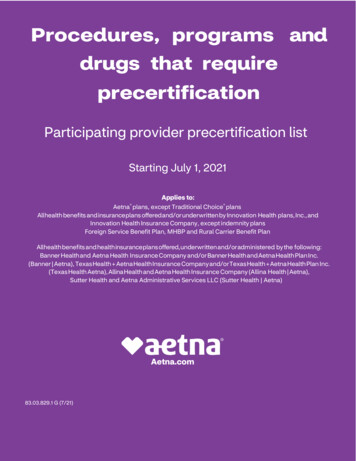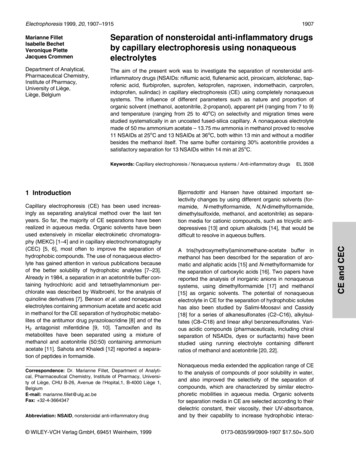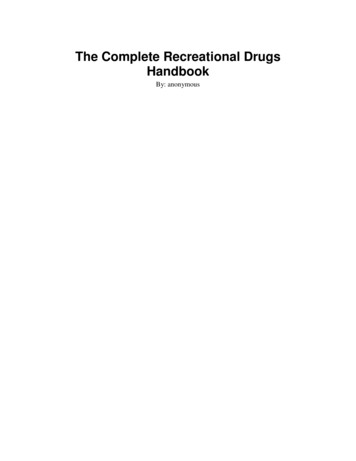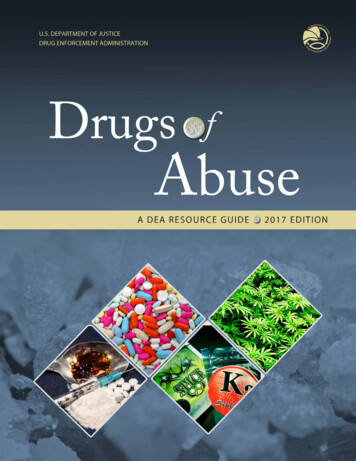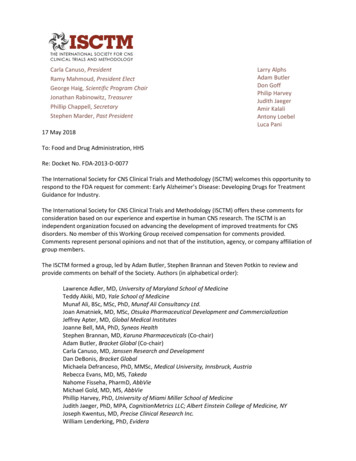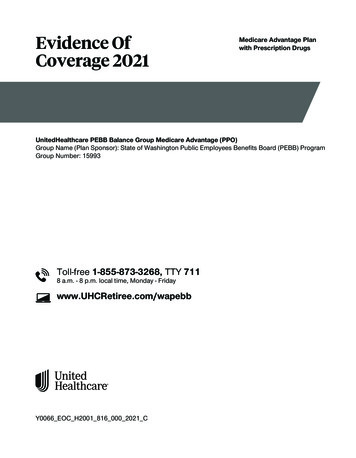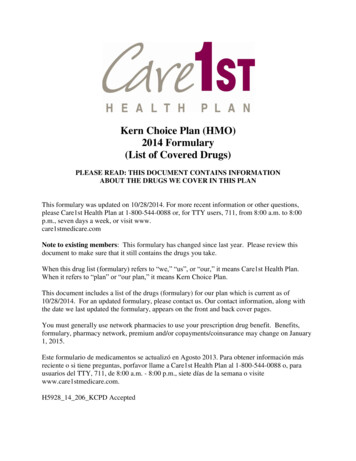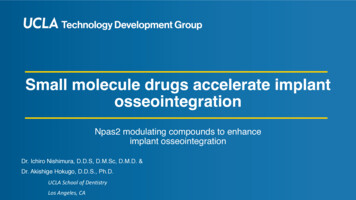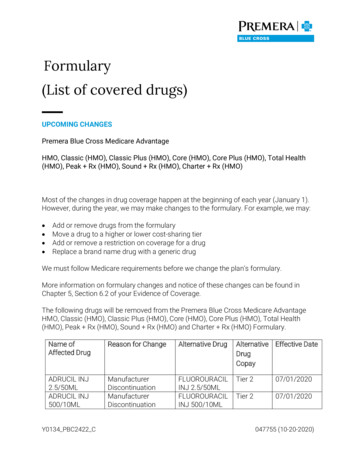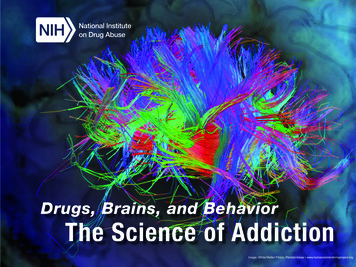
Transcription
Drugs, Brains, and BehaviorThe Science of AddictionImage: White Matter Fibers, Parietal Areas www.humanconnectomeproject.org
This publication is in the public domain and may be used or reproduced in its entiretywithout permission from NIDA. Citation of the source is appreciated.NIH Pub No. 14-5605Printed April 2007Revised February 2008, August 2010, July 2014
CONTENTSPreface . 1Introduction . 3I. Drug Abuse and Addiction . 5II. Preventing Drug Abuse: The Best Strategy. 11III. Drugs and the Brain. 15IV. Addiction and Health. 21V. Treatment and Recovery . 25VI. Advancing Addiction Science and Practical Solutions. 29References . 31I
“Drug addiction is a brain disease that can be treated.”Nora D. Volkow, M.D.DirectorNational Institute on Drug Abuse
PREFACEHow Science Has Revolutionized the Understanding of Drug AddictionFor much of the past century, scientists studying drug abuse labored in the shadows of powerful myths and misconceptions about thenature of addiction. When scientists began to study addictive behavior in the 1930s, people addicted to drugs were thought to bemorally flawed and lacking in willpower. Those views shaped society’s responses to drug abuse, treating it as a moral failing ratherthan a health problem, which led to an emphasis on punishment rather than prevention and treatment. Today, thanks to science, our viewsand our responses to addiction and other substance use disorders have changed dramatically. Groundbreaking discoveries about the brainhave revolutionized our understanding of compulsive drug use, enabling us to respond effectively to the problem.As a result of scientific research, we know that addiction is a disease that affects both the brain and behavior. We have identified many of thebiological and environmental factors and are beginning to search for the genetic variations that contribute to the development andprogression of the disease. Scientists use this knowledge to develop effective prevention and treatment approaches that reduce the tolldrug abuse takes on individuals, families, and communities.Despite these advances, many people today do not understand why people become addicted to drugs or how drugs change the brain tofoster compulsive drug use. This booklet aims to fill that knowledge gap by providing scientific information about the disease of drugaddiction, including the many harmful consequences of drug abuse and the basic approaches that have been developed to prevent and treatsubstance use disorders. At the National Institute on Drug Abuse (NIDA), we believe that increased understanding of the basics of addictionwill empower people to make informed choices in their own lives, adopt science-based policies and programs that reduce drug abuse andaddiction in their communities, and support scientific research that improves the Nation’s well-being.1Nora D. Volkow, M.D.DirectorNational Institute on Drug Abuse
MEDICALSOCIALECONOMICCRIMINAL JUSTICEThe consequences of drug abuse are vast and variedand affect people of all ages.
INTRODUCTIONWhy study drug abuse and addiction?Abuse of and addiction to alcohol, nicotine, and illicit and prescription drugs cost Americans more than 700 billion a year inincreased health care costs, crime, and lost productivity.1,2,3 Every year, illicit and prescription drugs and alcohol contribute to thedeath of more than 90,000 Americans, while tobacco is linked to an estimated 480,000 deaths per year.4,5 (Hereafter, unlessotherwise specified, drugs refers to all of these substances.)People of all ages suffer the harmful consequences of drug abuse and addiction.z Babies exposed to drugs in the womb may be born premature and underweight. This exposure can slow the child’s intellectualdevelopment and affect behavior later in life.6z Adolescents who abuse drugs often act out, do poorly academically, and drop out of school. They are at risk for unplannedpregnancies, violence, and infectious diseases.z Adults who abuse drugs often have problems thinking clearly, remembering, and paying attention. They often develop poor socialbehaviors as a result of their drug abuse, and their work performance and personal relationships suffer.z Parents’ drug abuse often means chaotic, stress-filled homes, as well as child abuse and neglect. Such conditions harm the well-being and development of children in the home and may set the stage for drug abuse in the next generation.How does science provide solutions for drug abuse and addiction?Scientists study the effects that drugs have on the brain and on people’s behavior. They use this information to develop programs forpreventing drug abuse and for helping people recover from addiction. Further research helps transfer these ideas into practice in ourcommunities.3
I. DRUG ABUSE AND ADDICTIONWhat is drug addiction?Addiction is a lot like other diseases,such as heart disease. Both disrupt thenormal, healthy functioning of theunderlying organ, have serious harmfulconsequences, and are preventable andtreatable, but if left untreated, can lasta lifetime.Source: From the laboratories ofDrs. N. Volkow and H. Schelbert5Healthy BrainDiseased Brain/Cocaine AbuserDECREASED HEART METABOLISM INHEART DISEASE PATIENTLOWAddiction is defined as a chronic, relapsing braindisease that is characterized by compulsive drugseeking and use, despite harmful consequences.†It is considered a brain disease because drugs change thebrain—they change its structure and how it works. Thesebrain changes can be long-lasting, and can lead to theharmful behaviors seen in people who abuse drugs.HIGHDECREASED BRAIN METABOLISM IN PERSON WHO ABUSES DRUGSHealthy HeartDiseased Heart†The term addiction as used in this booklet may be regarded as equivalent to a severe substance use disorder as defined by the Diagnostic and Statistical Manual ofMental Disorders, Fifth Edition (DSM-5, 2013).
6Why do people take drugs?In general, people begin taking drugs for a variety of reasons:z To feel good. Most abused drugs produce intense feelings of pleasure. This initial sensation of euphoria is followed by other effects, which differwith the type of drug used. For example, with stimulants such as cocaine, the “high” is followed by feelings of power, self-confidence, andincreased energy. In contrast, the euphoria caused by opiates such as heroin is followed by feelings of relaxation and satisfaction.z To feel better. Some people who suffer from social anxiety, stress-related disorders, anddepression begin abusing drugs in an attempt to lessen feelings of distress. Stress can play amajor role in beginning drug use, continuing drug abuse, or relapse in patients recovering fromaddiction.z To do better. Some people feel pressure tochemically enhance or improve their cognitive orathletic performance, which can play a role in initialexperimentation and continued abuse of drugs suchas prescription stimulants or anabolic/androgenicsteroids.In this respect adolescents are particularly vulnerablebecause of the strong influence of peer pressure.Teens are more likely than adults to engage in risky ordaring behaviors to impress their friends and expresstheir independence from parental and social rules.Courtesy: Vivian Felsenz Curiosity and “because others are doing it.”
No single factor determines whether a personwill become addicted to drugs.7If taking drugs makes people feel good orbetter, what’s the problem?When they first use a drug, people may perceive what seem tobe positive effects; they also may believe that they can controltheir use. However, drugs can quickly take over a person’s life.Over time, if drug use continues, other pleasurable activitiesbecome less pleasurable, and taking the drug becomes necessary for the user just to feel “normal.” They may then compulsively seek and take drugs even though it causes tremendousproblems for themselves and their loved ones. Some people maystart to feel the need to take higher or more frequent doses,even in the early stages of their drug use. These are the telltalesigns of an addiction.Even relatively moderate drug use poses dangers. Consider howa social drinker can become intoxicated, get behind the wheelof a car, and quickly turn a pleasurable activity into a tragedythat affects many lives.Is continued drug abuse a voluntarybehavior?The initial decision to take drugs is typically voluntary. However,with continued use, a person’s ability to exert self-control canbecome seriously impaired; this impairment in self-control isthe hallmark of addiction. Brain imaging studies of people withaddiction show physical changes in areas of the brain that arecritical to judgment, decision making, learning and memory,and behavior control.7 Scientists believe that these changes alterthe way the brain works and may help explain the compulsiveand destructive behaviors of addiction.Why do some people become addicted todrugs, while others do not?As with any other disease, vulnerability to addiction differs fromperson to person, and no single factor determines whether aperson will become addicted to drugs. In general, the more riskfactors a person has, the greater the chance that taking drugsRISK AND PROTECTIVE FACTORSFOR DRUG ABUSE AND ADDICTIONRisk FactorsProtective FactorsAggressive behaviorin childhoodGood self-controlLack of parentalsupervisionParental monitoringand supportPoor social skillsDrug experimentationPositive relationshipsAcademic competenceAvailability of drugsat schoolCommunity povertySchool anti-drugpoliciesNeighborhood pride
8Children’s earliest interactions within the familyare crucial to their healthy development andrisk for drug abuse.will lead to abuse and addiction. Protective factors, onthe other hand, reduce a person’s risk of developingaddiction. Risk and protective factors may be either environmental (such as conditions at home, at school, and inthe neighborhood) or biological (for instance, a person’sgenes, their stage of development, and even their genderor ethnicity).RISK FACTORSnnnGeneticsGenderMental disordersnnRoute of administrationEffect of drug itselfnnnEarly useAvailabilityCostnnnnnChaotic home and abuseParent’s use and attitudesPeer influencesCommunity attitudesPoor school achievementWhat environmental factors increasethe risk of addiction?z Home and Family. The influence of the home envi-ronment, especially during childhood, is a very important factor. Parents or older family members who abusealcohol or drugs, or who engage in criminal behavior,can increase children’s risks of developing their owndrug problems.z Peer and School. Friends and acquaintances can havean increasingly strong influence during adolescence.Drug-using peers can sway even those without risk factors to try drugs for the first time. Academic failure orpoor social skills can put a child at further risk forusing or becoming addicted to drugs.What biological factors increase the risk of addiction?Scientists estimate that genetic factors account for between 40 and 60 percent of aperson’s vulnerability to addiction; this includes the effects of environmental factorson the function and expression of a person’s genes. A person’s stage of developmentand other medical conditions they may have are also factors. Adolescents and peoplewith mental disorders are at greater risk of drug abuse and addiction than the generalpopulation.
9What other factors increase the risk ofaddiction?z Early Use. Although taking drugs at any age can lead to addiction,research shows that the earlier a person begins to use drugs, themore likely he or she is to develop serious problems.8 This mayreflect the harmful effect that drugs can have on the developingbrain; it also may result from a mix of early social and biologicalvulnerability factors, including unstable family relationships,exposure to physical or sexual abuse, genetic susceptibility, ormental illness. Still, the fact remains that early use is a strongindicator of problems ahead, including addiction.z Method of Administration. Smoking a drug or injecting it intoa vein increases its addictive potential.9,10 Both smoked and injecteddrugs enter the brain within seconds, producing a powerful rushof pleasure. However, this intense “high” can fade within a fewminutes, taking the abuser down to lower, more normal levels.Scientists believe this starkly felt contrast drives some people torepeated drug taking in an attempt to recapture the fleetingpleasurable state.
Addiction is a developmental disease—it typically begins in childhood or adolescence.10The brain continues to develop into adulthoodand undergoes dramatic changes duringadolescence.ImAGeS OF bRAIN DeveLOPmeNT INHeALTHy CHILDReN AND TeeNS (AGeS 5–20)AGeS520SIDE VIEWOne of the brain areas still maturing during adolescence is theprefrontal cortex—the part of the brain that enables us to assesssituations, make sound decisions, and keep our emotions anddesires under control.11 The fact that this critical part of anadolescent’s brain is still a work in progress puts them atincreased risk for making poor decisions (such as trying drugsor continuing to take them). Also, introducing drugs during thisperiod of development may cause brain changes that haveprofound and long-lasting consequences.Prefrontal CortexTOP VIEWBlue represents maturing of brain areas.Source: PNAS 101:8174–8179, 2004.
II. PREVENTING DRUG ABUSE:THE BEST STRATEGYWhy is adolescence a critical time for preventing drug addiction?As noted previously, early use of drugs increases a person’s chances of developing addiction. Remember, drugs change brains—andthis can lead to addiction and other serious problems. So, preventing early use of drugs or alcohol may go a long way in reducingthese risks. If we can prevent young people from experimenting with drugs, we can prevent drug addiction.Risk of drug abuse increases greatly during times of transition. For an adult, a divorce or loss of a job may lead to drug abuse; for a teenager, risky times include moving or changing schools.12 In early adolescence, when children advance from elementary through middle school,they face new and challenging social and academic situations. Often during this period, children are exposed to abusable substances such ascigarettes and alcohol for the first time. When they enter high school, teens may encounter greater availability of drugs, drug use by olderteens, and social activities where drugs are used.At the same time, many behaviors that are a normal aspect of their development, such as the desire to try new things or take greater risks,may increase teen tendencies to experiment with drugs. Some teens may give in to the urging of drug-using friends to share the experiencewith them. Others may think that taking drugs (such as steroids) will improve their appearance or their athletic performance or that abusingsubstances such as alcohol or MDMA (ecstasy or “Molly”) will ease their anxiety in social situations. A growing number of teens are abusingprescription ADHD stimulants such as Adderall to help them study or lose weight. Teens’ still-developing judgment and decision-makingskills may limit their ability to accurately assess the risks of all of these forms of drug use.Using abusable substances at this age can disrupt brain function in areas critical to motivation, memory, learning, judgment, and behaviorcontrol.7 So, it is not surprising that teens who use alcohol and other drugs often have family and social problems, poor academic performance, health-related problems (including mental health), and involvement with the juvenile justice system.11
National drug use surveys indicate some children arealready using drugs by age 12 or 13.12Percentage of Past-Year Initiates among Those Who Have Never UsedThe Drug Danger Zone: Most Illicit Drug Use Starts in the Teenage .9%21-25226 orOlder12-130Age GroupSource: SAMHSA, Center for Behavioral Health Statistics and Quality,National Survey on Drug Use and Health, 2011 and 2012.Can research-based programsprevent drug addiction inyouth?Yes. The term “research-based” means thatthese programs have been rationally designedbased on current scientific evidence, rigorously tested, and shown to produce positiveresults. Scientists have developed a broadrange of programs that positively alter thebalance between risk and protective factorsfor drug abuse in families, schools, andcommunities. Studies have shown thatresearch-based programs, such as thosedescribed in NIDA’s Preventing Drug Useamong Children and Adolescents: AResearch-Based Guide for Parents,Educators, and Community Leaders, cansignificantly reduce early use of tobacco,alcohol, and illicit drugs.13
13How do research-based prevention programs work?These prevention programs work to boost protective factors and eliminate or reduce risk factors for drug use. The programs aredesigned for various ages and can be designed for individual or group settings, such as the school and home. There are threetypes of programs:z Universal programs address risk and protective factors common to all children in a given setting, such as a school orcommunity.z Selective programs target groups of children and teens who have factors that put them at increased risk of drug use.z Indicated programs are designed for youth who have already begun using drugs.Are all prevention programs effective in reducing drug abuse?When research-based substance use prevention programs are properly implemented by schools and communities, use of alcohol, tobacco, and illegal drugs is reduced. Such programs help teachers, parents, and health care professionals shape youths’perceptions about the risks of substance use. While many social and cultural factors affect drug use trends, when young peopleperceive drug use as harmful, they reduce their level of use.14
Prevention is the best strategy14DRUG USe DeCReASeS WHeN DRUGS ARe PeRCeIveD AS HARmFUL, AND vICe veRSA12TH-GRADe STUDeNTS RePORTING PAST-mONTHmARIJUANA USe AND PeRCePTION OF HARm,1975 TO 201312TH-GRADe STUDeNTS RePORTING PAST-mONTHCIGAReTTe USe AND PeRCePTION OF HARm,1975 TO 2013808070n Perceived Risk of Harmn Past-Year Use7060Percent50n Perceived Risk of Harmn 1/2 a pack /day40Percent605030402030100Cigarette smokingamong teens is at itslowest point sinceNIDA began trackingit in 1975. Butmarijuana use hasincreased over thepast several years asperception of itsrisks has declined.20YearYearSource: 2013 Monitoring the Future survey. University of Michigan, with funding from the National Institute on Drug Abuse.For more information on prevention, see NIDA’s most recent edition of Preventing Drug Use among Children and Adolescents: A ResearchBased Guide for Parents, Educators, and Community Leaders at www.drugabuse.gov/Prevention/Prevopen.html.
III. DRUGS AND THE BRAINIntroducing the Human brainThe human brain is the most complex organ in the body. This three-pound mass of gray and white matter sits at the center of allhuman activity—you need it to drive a car, to enjoy a meal, to breathe, to create an artistic masterpiece, and to enjoy everyday activities. In brief, the brain regulates your body’s basic functions; enables you to interpret and respond to everything you experience; andshapes your thoughts, emotions, and behavior.The brain is made up of many parts that all work together as a team. Different parts of the brain are responsible for coordinating and performing specific functions. Drugs can alter important brain areas that are necessary for life-sustaining functions and can drive the compulsive drug abuse that marks addiction. Brain areas affected by drug abuse include:z The brain stem, which controls basic functions critical to life, such as heart rate, breathing, and sleeping.z The cerebral cortex, which is divided into areas that control specific functions.Different areas process information from our senses, enabling us to see, feel, hear, andtaste. The front part of the cortex, the frontal cortex or forebrain, is the thinking centerof the brain; it powers our ability to think, plan, solve problems, and make decisions.z The limbic system, which contains the brain’s reward circuit. It links together anumber of brain structures that control and regulate our ability to feel pleasure. Feelingpleasure motivates us to repeat behaviors that are critical to our existence. The limbicsystem is activated by healthy, life-sustaining activities such as eating and socializing—but it is also activated by drugs of abuse. In addition, the limbic system is responsiblefor our perception of other emotions, both positive and negative, which explains themood-altering properties of many drugs.15
16How do the parts of the brain communicate?The brain is a communications center consisting of billions ofneurons, or nerve cells. Networks of neurons pass messages backand forth among different structures within the brain, the spinal cord,and nerves in the rest of the body (the peripheral nervous system).These nerve networks coordinate and regulate everything we feel,think, and do.z Neuron to NeuronEach nerve cell in the brain sends and receives messages in theform of electrical and chemical signals. Once a cell receives andprocesses a message, it sends it on to other neurons.Here’s how people communicate.TransmitterConcept courtesy: B.K. MadrasReceptorz Neurotransmitters—The Brain’s Chemical MessengersThe messages are typically carried between neurons by chemicalscalled neurotransmitters.z Receptors—The Brain’s Chemical ReceiversThe neurotransmitter attaches to a specialized site on the receivingneuron called a receptor. A neurotransmitter and its receptor operate like a “key and lock,” an exquisitely specific mechanism thatensures that each receptor will forward the appropriate messageonly after interacting with the right kind of neurotransmitter.z Transporters—The Brain’s Chemical RecyclersLocated on the neuron that releases the neurotransmitter, transporters recycle these neurotransmitters (that is, bring them backinto the neuron that released them), thereby shutting off the signalbetween neurons.Here’s how brain cells communicate.NeurotransmitterReceptorTo send a message, a braincell (neuron) releases achemical (neurotransmitter)into the space (synapse)between it and the nextcell. The neurotransmittercrosses the synapse andattaches to proteins (receptors) on the receiving braincell. This causes changes inthe receiving cell—themessage is delivered.
Most drugs of abuse target the brain’s rewardsystem by flooding it with dopamine.How do drugs work in the brain?Drugs are chemicals that affect the brain by tapping into its communication system and interfering with the way neuronsnormally send, receive, and process information. Some drugs, such as marijuana and heroin, can activate neurons because theirchemical structure mimics that of a natural neurotransmitter. This similarity in structure “fools” receptors and allows the drugsto attach onto and activate the neurons. Although these drugs mimic the brain’s own chemicals, they don’t activate neurons in thesame way as a natural neurotransmitter, and they lead to abnormal messages being transmitted through the network.Other drugs, such as amphetamine or cocaine, can cause the neurons to release abnormally large amounts of natural neurotransmitters or prevent the normal recycling of these brain chemicals. This disruption produces a greatly amplified message,ultimately disrupting communication channels.How do drugs work in the brain to produce pleasure?Most drugs of abuse directly or indirectly target the brain’s reward system by flooding the circuit with dopamine. Dopamine is aneurotransmitter present in regions of the brain that regulate movement, emotion, motivation, and feelings of pleasure. Whenactivated at normal levels, this system rewards our natural behaviors. Overstimulating the system with drugs, however, produceseuphoric effects, which strongly reinforce the behavior of drug use—teaching the user to repeat it.17
18How does stimulation of the brain’spleasure circuit teach us to keeptaking drugs?Why are drugs more addictive thannatural rewards?When some drugs of abuse are taken, they can release 2 to 10 timesthe amount of dopamine that natural rewards such as eating and sexOur brains are wired to ensure that we will repeat life-sustaining activdo.15 In some cases, this occurs almost immediately (as when drugsities by associating those activities with pleasure or reward. Wheneverare smoked or injected), and the effects can last much longer thanthis reward circuit is activated, the brain notes that something importhose produced by natural rewards. The resulting effects on the brain’stant is happening that needs to be remembered, and teaches us to do itpleasure circuit dwarf those produced by naturally rewarding behavagain and again without thinking about it. Because drugs of abuseiors.16,17 The effect of such a powerful reward strongly motivates peostimulate the same circuit, we learn to abuse drugs in the same way.ple to take drugs again and again.This is why scientists sometimes sayDRUGS OF AbUSe TARGeT THe bRAIN’S PLeASURe CeNTeRthat drug abuse is something welearn to do very, very well.Brain reward (dopamine) pathwaysDrugs of abuse increase tal NucleusAccumbensWHILE EATING FOODThese brain circuits are important for naturalrewards such as food, music, and sex.CocaineDopamineWHILE USING COCAINETypically, dopamine increases in response to natural rewards such as food.When cocaine is taken, dopamine increases are exaggerated, and communication is altered.
Long-term drug abuse impairs brain functioning.19What happens to your brainif you keep taking drugs?For the brain, the difference between normal rewards anddrug rewards can be described as the difference betweensomeone whispering into your ear and someone shoutinginto a microphone. Just as we turn down the volume on aradio that is too loud, the brain adjusts to the overwhelm-DeCReASeD DOPAmINe TRANSPORTeRS IN A18meTHAmPHeTAmINe AbUSeRing surges in dopamine (and other neurotransmitters) byproducing less dopamine or by reducing the number ofreceptors that can receive signals. As a result, dopamine’simpact on the reward circuit of the brain of someone whoabuses drugs can become abnormally low, and that person’s ability to experience any pleasure is reduced.This is why a person who abuses drugs eventually feels flat,lifeless, and depressed, and is unable to enjoy things thatwere previously pleasurable. Now, the person needs tokeep taking drugs again and again just to try and bring hisor her dopamine function back up to normal—which onlymakes the problem worse, like a vicious cycle. Also, theperson will often need to take larger amounts of the drugto produce the familiar dopamine high—an effect knownas tolerance.How does long-term drug taking affectbrain circuits?Healthy ControlDrug AbuserWe know that the same sort of mechanisms involved in thedevelopment of tolerance can eventually lead to profoundchanges in neurons and brain circuits, with the potential toseverely compromise the long-term health of the brain. For
20example, glutamate is another neurotransmitter that influences thereward circuit and the ability to learn. When the optimal concentrationof glutamate is altered by drug abuse, the brain attempts to compensate for this change, which can cause impairment in cognitive function.Similarly, long-term drug abuse can trigger adaptations in habit ornon-conscious memory systems. Conditioning is one example of thistype of learning, in which cues in a person’s daily routine or environment become associated with the drug experience and can triggeruncontrollable cravings whenever the person is exposed to these cues,even if the drug itself is not available. This learned “reflex” is extremely durable and can affect a person who once used drugs even aftermany years of abstinence.What other brain changesoccur with drug abuse?Chronic exposure to drugs of abuse disrupts the way critical brainstructures interact to control and inhibit behaviors related to drug use.Just as continued abuse may lead to tolerance or the need for higherdrug dosages to produce an effect, it may also lead to addiction, whichcan drive a user to seek out and take drugs compulsively. Drug addiction erodes a person’s self-control and ability to make sound decisions, while producing intense impulses to take drugs.For more information on drugs and the brain, order NIDA’s Teaching Packets CD-ROM series or the Mind Over Matter series atwww.drugabuse.gov/parent-teacher.html. These items and others are avai
the hallmark of addiction. Brain imaging studies of people with addiction show physical changes in areas of the brain that are critical to judgment, decision making, learning and memory, and behavior control.7Scientists believe that these changes alter the way the brain works and may hel


